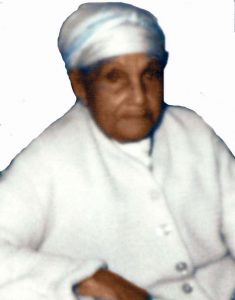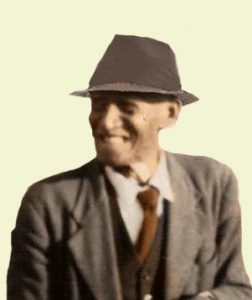
Grandma Mary Hill-Ford was the oldest of five children born to Charlie and Nancy Hill. She was born around 1870 in Columbia County (near Lake City) Florida where she grew up and remained there until around 1895 when she met and married Charlie Ford. Shortly thereafter they moved to Suwannee County (near Live Oak) Florida. This union would last 67 years until Grandpa Charlie’s death in 1962. They were the parents of thirteen children; Lonnie Ford, Rev. Henry Ford, Ethel Ford, Rev. Sidney Ford, Arlene Ford, Rev Harvey Ford, Earnest Ford, Timothy Ford, Ruby Ford, Rev Lee Andrew Ford, Rev Verdis Ford, Ernestine Ford, and Felton Ford. They raised them on a 200-acre farm that they purchased in the late 1890s, located in what is now known as Clay-Woods community, five-mile west of Live Oak Florida. Currently, the lime-rock road just off Highway 51 that leads to Queen Chapel Church runs through the middle of the old Ford home place.
At a very young age, she became a Christian and remained
devoted to the cause of Christ throughout her life. She no doubt was influenced by her Godly mother Nancy Hill who was a faithful follower of Christ and cofounder of Queen Chapel Church. Grandma Mary Loved Queen Chapel Church and was a faithful member for nearly sixty years. It is where she took her children and grandchildren to receive Jesus Christ as their Savior.
Grandma Mary lived her entire life during a time of extreme oppression. Her faith enabled her to bear the twin monsters of racial and gender discrimination with dignity and grace.
Although she was denied the opportunity to get a formal
education it did not hinder her spiritual growth… she was a
giant in the faith. It is a testament to her devotion to Christ that five of her eight sons became ministers of the gospel. It was Grandma Mary’s persistent intercessory prayers that finally drew her husband Grandpa Charlie to accept Christ late in his life. Grandpa Charlie was over sixty years old when he was
baptized.
Grandma Mary loved her family. She was the uniting force that held her family together. When her children became adults and left home; some of them moved away to large northern cities in pursuit of a better life. She summoned them all back home at least once a year to celebrate Christmas. Her home was the meeting place where all her children and their families which
included a host of grandchildren and great-grandchildren would gather for Christmas dinner. Her Christmas dinners were more like a feast that featured turkey, ham, and of course chitlins with all the trimmings… It also included assorted layer cakes, potato pies, and lots of other goodies. She diligently prepared all the food from scratch and cooked on a wood-burning stove. Grandma’s mouthwatering food alone was enough to draw
everybody back home with anticipation of a meal that only she could make.
The gatherings at Grandma Mary’s house for Christmas dinner were in effect the forerunner of our present-day Family Reunions. In fact, part of the goal of our family reunions is to replicate the effect of those Christmas gatherings at Grandma’s house. “To foster family strength, nurture individual hope, and perpetuate family values. Most importantly our Family reunions are a catalyst for passing on our Christian heritage imitating this saintly God-fearing lady.
Grandma Mary had three sisters; Laura, Bessie, and Christine, and one brother; Grant.

Grandpa Charlie Ford was born a slave in 1861 in the state of South Carolina. His father Jonathan Williams was a Caucasian slave-owner who owned his slave mother. At his birth, he was named Cornelius (Neil) Williams. It was common practice for children born into slavery to take the surname of their owner. In Neil’s case his owner, Mr. Williams, was also his actual father. Neil was four years old when President Abraham Lincoln signed the emancipation proclamation that legally ended slavery. However, his mother and her seven children, including young Neil remained on Mr. Williams’ plantation. Strangely enough, it was not uncommon for freed slaves, to stay with their previous owner after they were freed. This is indeed a sad commentary on the cruelty of slavery. It robbed them of their dignity, stole their humanity, and relegated them to the status of the property. Consequently, when freedom finally came they lacked the capacity to cope with the burden of freedom. So they stayed and continued to work the cotton fields for “ol’ massa” whose token acknowledgment of their freedom was to share the crop. This system became known as “share-cropping”. For sure, the freed slaves and “ol massa” were not equal partners in this share-cropping arrangement by any means. “Ol massa” who still owned the land, agreed to provide the housing, equipment, and supplies. The freed slaves, whose only asset was their ability to work the fields, provided the labor for a share of the crop. In reality, share-cropping was little more than a modified version of the old slave system. “Ol Massa” gained a new title; “boss man”. And he maintained complete autonomy in controlling the profit and dividing the crop. The former slave’s share of the crop was at the discretion of “boss man” and was usually insufficient to pay their debt to “boss man” for the supplies, food, clothing, and housing. Accordingly, at the end of each accounting year, the former slaves fell deeper and deeper in debt until after a few years they found themselves virtually owned by” boss man”. As it was under the legal slave system, boss-man resided in the big house on the hill and former slaves inhabited the shanty shacks in the valley. Share-cropping arrangements remained in the south until the 1960s. The residual effects of slavery still haunt us even today.
In spite of the oppressive conditions under which young Neil grew up, he acquired a high school education at a time when schooling was virtually nonexistent for most black people. This suggests that Neil had a favorable relationship with his well-to-do father who apparently arranged for his schooling. As a young man, Neil left South Carolina and went up north to New York in pursuit of a better life. Not much is known about his experiences in New York. However, according to his own account, after a few years in New York City, he ran a fowl with the law. To escape he hiked a southbound train and eventually wound up in Suwannee County Florida in the early 1890s. Once there he changed his name from Cornelius Williams to Charlie Ford. Thus the Ford legend begins. In 1895 he met and married 19-year-old Mary Hill after a whirlwind romance. This union would last 67 years until his death in 1962 at the age of 101. He fathered thirteen children; Lonnie Ford, Rev. Henry Ford, Ethel Ford, Rev. Sidney Ford, Arlene Ford, Rev Harvey Ford, Earnest Ford, Timothy Ford, Ruby Ford, Rev Lee Andrew Ford, Rev Verdis Ford, Ernestine Ford, and Felton Ford. And he raised them on a 200-acre farm that he purchased in the late 1890s, located in what is now known as Clay-Woods community, five-mile west of Live Oak Florida. Currently, the lime-rock road just off Highway 51 that leads to Queen Chapel Church runs through the middle of the old Ford home place
In 1956 four of his sons, Sidney, Harvey, Timothy, and Earnest visit Society Hill South Carolina where Cornelius Williams AKA. Charlie Ford grew up and had leftover 60 years earlier. They met for the first time a host of uncles, Aunts, and cousins.
